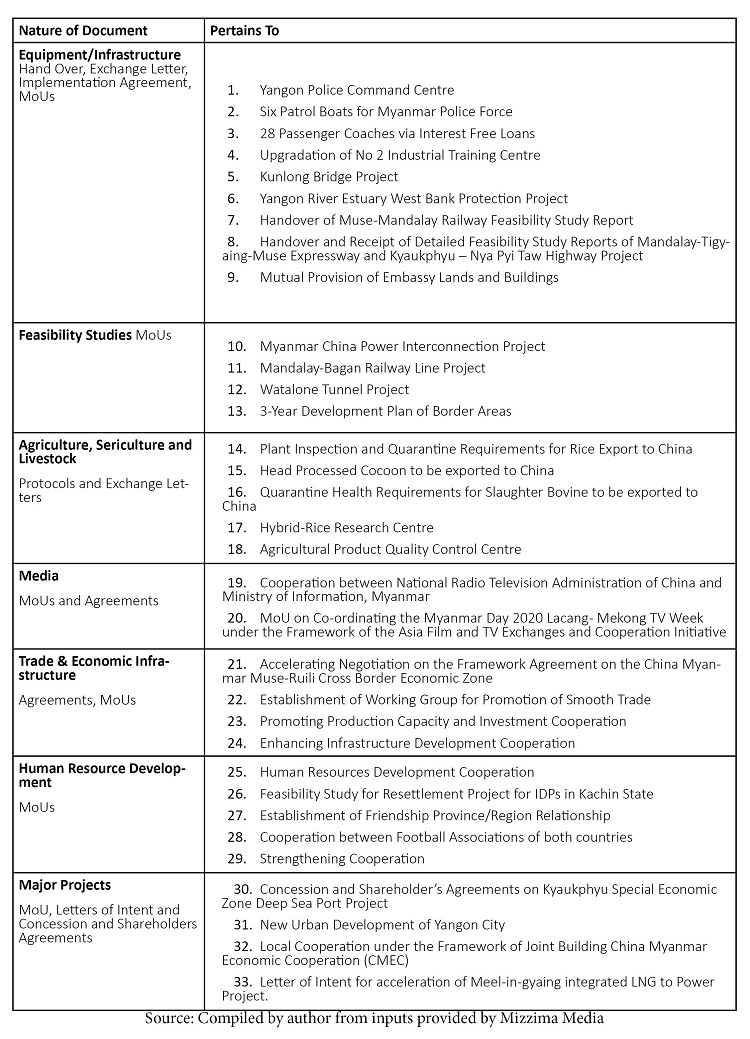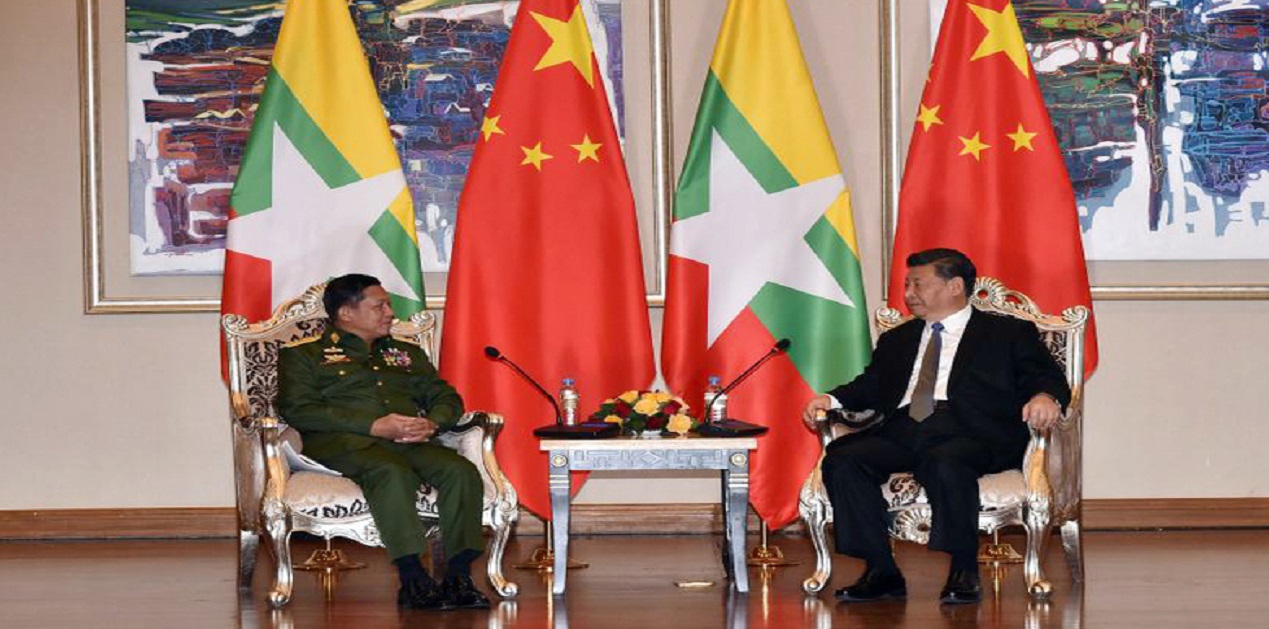Background
Myanmar effectively boarded the BRI when Aung San Suu Kyi attended the First Belt and Road Forum for International Cooperation in Beijing in May 2017. President Xi Jinping even acknowledged Myanmar in the context of the BRI in his speech at the Forum.1 Daw Suu subsequently attended the Second Belt and Road Forum in April 2019 where nine deliverables including three bilateral ones were actually agreed upon out of the 38 proposed by China as ‘early harvest’ projects. The three bilaterals included an agreement on economic and technical cooperation, an MoU on a five year economic and trade development cooperation plan (with a 1 billion yuan i.e. US$144.5 million grant), and an MoU on the China-Myanmar Economic Corridor (CMEC) Plan spanning from 2019 to 2030.2 However 29 projects were not signed given the conservative approach due to the dubious Chinese reputation in matters of debt. 3,4
This first visit by the Chinese President Xi Jinping5 on 17-18 January 2020 was ostensibly to commemorate 70 years of diplomatic relations between the two nations. The stated aims of the visit as articulated by Chinese Vice Foreign Minister Luo Zhaohui during media interactions in Beijing on 17 January 2020 were to strengthen relations; deepen Belt and Road Initiative cooperation and to "materialise" the China-Myanmar Economic Corridor (CMEC) i.e. the Myanmar component of the belt and road initiative.
Typically, it was preceded by a visit by the Chinese State Counsellor and Foreign Minister Wang Yi who met the entire Myanmar national leadership including the military on 7 December 2019. Both sides expressed the usual platitudes though Wang Yi described the relation as a ‘baobo’ (friends and relatives) relationship between the two countries…a step forward from the clichéd ‘pauk phaw’ (fraternal) relationship. 6,7
Xi Jinping’s Press Article
To set the tone for the visit, a nearly 1300 word signed article by the Chinese President entitled " Writing a New Chapter in Our Millennia-Old Pauk-Phaw Friendship" was carried by three Myanmar newspapers viz. Myanma Alinn Daily, The Mirror and The Global New Light of Myanmar, on 16 January 2020, a day prior to the commencement of the visit. While the first seven paragraphs of the largely rhetorical article carries reinforcing examples of China Myanmar cooperation, it is the last five paragraphs that hope to set the tone for next few decades of interaction. It is liberally littered with assertions of a ‘new chapter’, ‘new blueprint’, ‘new impetus’, ‘new substance’, ‘new progress’, ‘new type of international relations’ and the most bandied ‘new era’ hoping to ‘continue’, ‘deepen’, ‘promote’, ‘scale (ing) up’ and ‘communicate (ion)’ from this ‘new starting point’.8 This in essence has been the crux of the visit…no changes, just new jingoism in realisation of the fact that Myanmar has wisened up to the stresses associated with high debt.9 Once the grandiose jargon has been sifted through, what it reveals is essentially old wine in a ‘new era’!10
Posturing
The optics of the visit far exceeds the bilateral benefits as will be evident when we examine the documents signed during the event. However the visit is essentially an opportunity for both nations for posturing to the international community. The timing of the visit should not be lost sight of, being just before 23 January 2020, the day the International Court of Justice (ICJ) will pass judgement on the Gambian complaint against the alleged Myanmar perpetrated genocide against the Rohingyas. This association staves off potential Western sanctions and UN resolutions (China being a member of the P5) on Myanmar while providing it with investments and infrastructure. In return, China gets access to the Indian Ocean to hedge its Malacca chokepoint. Indeed, Myanmar has been described as the lynchpin to China’s geopolitical ambitions.11
The visit per se involved meetings with President U Win Myint, State Counsellor Daw Aung San Suu Kyi, Commander in Chief of Defence Services Ming Aung Hlaing and other unspecified political leaders and monks at Nay Pyi Taw. It also included ceremonies involving exchange of cooperative documents; 70th anniversary of China Myanmar diplomatic ties and the launch of the China Myanmar Year of Culture and Tourism.
Myitsone Dam Project continues to remain suspended
Significantly there was no mention of the contentious Myitsone Dam Project. 12 It is understood that President Xi is emotionally attached to the execution of the project given that it was signed by him as Vice President, a decade ago. Twitter was abuzz with rumours13 of the project being revived during this visit, but electoral14 wisdom on both sides ensured that the project did not find mention, at least in the public domain.
The wounds of the previous attempt at pushing the project are still raw and fresh in the minds of the Myanmar people. Two days prior to his visit, approximately 40 Kachin based Civil Society Organisations (CSOs) sent an open letter to President Xi to permanently terminate the suspended Myitsone Dam project, saying that the project threatens the prosperity of the Myanmar people and that friendly relations between the two countries will deteriorate if the project goes ahead.15 A proposal by CSOs to protest in front the Chinese Embassy in Yangon was also turned down by authorities.16
Documents Signed
President Xi witnessed the signing of a total of 33 myriad Memoranda of Understanding (MoU), Handover Certificates, Exchange Letters, Letters of Intents, Protocol Documents and Implementation Agreements of projects between the two sides over the two day visit.
A cursory look at the nature of the projects signed reveal no game changing ventures. The documents are intrinsically generic and mostly convey intent to cooperate rather than any major high value project execution. In most cases the details of the projects w.r.t bidding and financing are not finalised and are open to negotiation.17 This brings to mind that China is playing to the gallery while Myanmar is going along since there is no major high value controversial or negative project in the list. The need to steer clear of any Myitsone Dam type of project is paramount in view of Elections 2020. However, the existing large projects centred around Kyaukphyu will continue, albeit in a subdued and discreet manner. However even this project is fraught with danger of running into protests since many locals appeared unconvinced and have questioned whether the investment would benefit ordinary people.18
A summary of the documents signed are as under:

Media Overview
Surprisingly the English media was guarded and reticent about the event. Collin Koh writing for the South China Morning Post concluded that Myanmar’s image crisis constituted an opportunity for Beijing even as Myanmar continued the hedging game to maintain a strategic balance in the region.19 China is projecting a façade of being the ‘friendly giant in the neighbourhood’, but with increasing reports of its attempts to beleaguer countries with debt, the mask is slowly slipping off. 20 The traditional lack of transparency in projects cloaks the real intention and outcomes of these projects and feeds the local scepticism.21 A Nasdaq web article22 highlights how the investments have in effect ‘disrespected local traditions and values and failed to consult local people’, as stated in the open letter by the CSOs.
Further, Myanmar’s confidently candid approach to expose the Chinese policy of playing both sides and arming the Ethnic Armed Organisations (EAOs) operating in Myanmar, has put the Chinese on the back foot. Recent major arms recoveries by Myanmar including recovery of Chinese manufactured FN-6 shoulder fired anti-aircraft missiles has seen a flurry of nationalist outrage, underscoring the shadowy role of China.23 In the meeting with Myanmar Defence Services Commander in Chief, Chinese President Xi Jinping has had to deny that his country was supplying arms to EAOs in Myanmar, as per a press release by Tatmadaw (Defence Services) as quoted by Mizzima Media. President Xi has been quoted saying, “We categorically deny allegations of supplying arms to ethnic armed organizations in Myanmar but they can acquire these arms by other means, so that we will look into this issue thoroughly to resolve it.”24
The foundation of Chinese strategic interest in Myanmar has been laid at the port of Kyaukphyu, around which a plethora of ancillary projects will evolve, including transportation circuits, SEZs and even a resort and housing project in the vicinity. But the Rakhine people fear they will again be left in the lurch after previous Chinese infrastructure projects left them landless and without jobs. Kyaukphyu SEZ Watch Group representative Mr Moe Moe Aye informed that “They didn’t bring any benefits for us, not even any jobs”25.
What Next?
China has rushed in to occupy the diplomatic, economic and political space ceded to it by the Western withdrawal due to the outcry following the Rohingya Crisis. 26 But today Singapore upstaged China as the largest foreign investor in Myanmar,27 and Myanmar has more options for trade and investments from other Asian states, such as Japan, Korea, Thailand and India as well. What is emerging is that currently China needs Myanmar more than Myanmar needs China.28 Thus where Myanmar has hedged and spread its risk, China is at the mercy of Myanmar’s geo-strategic location and has no option but to depend on Myanmar to provide access to the Indian Ocean from Yunnan, a requirement to offset the Malacca chokepoint.
However, eager not to upset the apple cart, Myanmar continues to hedge its way to strategically balance China’s influence in its hinterland. Thus the period from now till the elections in November will see toned down activity on the BRI front. Daw Suu and the National League for Democracy (NLD) can ill afford more mass movements driven by anti-Chinese sentiments.
The Chinese belligerent tone and tenor in conduct of relations with Sri Lanka was being keenly watched in Myanmar. The arrogance of the statement by Foreign Minister Wang Yi that China ‘will not allow any outside influences to interfere with matters that are essentially internal concerns of Sri Lanka,’29 has not gone down well in Myanmar. Similarly the latest reports of China rewriting the Bible and Quran to interpret their beliefs in accordance with the core values of Socialism have not gone unnoticed.30 These factors will have a say in the Myanmar psyche, both at the national leadership level as well as at the ground level.
Options for India
A constant clamour for more proactive action by India in Myanmar has dominated the discourse.31 India too is as guilty of not seizing the opportunity to make a difference to Myanmar and thus to itself, as the West is, in shunning the Golden Land. Under these circumstances, what then, should be India’s vision for Myanmar and what should be the strategy to achieve that vision? India’s vision for Myanmar is direct fallout of Myanmar’s geo-strategic location and India Myanmar relations are bound by a shared heritage of religious, linguistic and ethnic ties. A stable Myanmar is essential for a stable North East India. Thus the genuine development of Myanmar is a primary vision and the corollary that emerges is that assisting Myanmar will enable it to stand on its own feet and reduce dependence on China thereby improving India’s security posture. With this as the broad concept of the vision, the strategy that evolves is documented in the succeeding paragraphs.
Firstly, it needs to be understood and acknowledged that India’s support to Myanmar cannot match Chinese investments dollar for dollar. However given the Indian goodwill in Myanmar, its investments and engagements need to be carried out through the prism of ‘hearts and minds’. The concept of ‘hearts and minds investments’ (HMI) involves reaching out to the locations and sectors which need investment of smaller scales but in greater numbers. The ‘hearts’ component involves identifying those areas and fields where investment is scarce and would have maximum impact for the locals without uprooting them from their traditional ways of life. The ‘minds’ component is to ensure that while meeting the requirements of the heart, the financial viability of projects is not compromised. Thus low but consistent and long-term profits, smaller scales of operations with lesser bureaucratic hurdles would take precedence over mega-projects and provide investment in geographical locations which are otherwise neglected. These investments are those that touch and benefit the common man and not just the local elites and the investors.
Secondly, the possibility of multi-national joint ventures needs to be considered and pushed by Myanmar and accepted by both China and India rather than traditional bilateral ventures especially between China and Myanmar. A good example runs astride the proposed China Myanmar Economic Corridor, viz. the Myanmar-China Gas Pipeline Project which is jointly invested and constructed by South East Asia Pipeline (SEAP) Company, Myanmar Oil and Gas Enterprise (MOGE), POSCO DAEWOO, ONGC CASPIAN E&P B.V. (OCEBV), Gas Authority of India Limited (GAIL) and Korea Gas Corporation (KOGAS). The South-East Asia Gas Pipeline Company Limited (SEAGP) is responsible for its operation and management.32 Involvement of multi-national entities brings expertise to the fore and by default induces checks and balances into the systems which tend to neutralize Chinese monopoly and brings objectivity into the projects. This way Indian investors too have a stake in the activities, and the presence of Indian and other investors increases the confidence of Myanmar investors and people. India driven alliances may provide the reliable alternative source of ‘heart and minds investments’ using groupings involving BIMSTEC or the India ASEAN networks or even as an alliance with Japan.33
Finally, India has no option but to evolve systems to deliver projects on timelines and within the budgeted costs. The implementation of the Kaladaan Multi-Modal Transit Transportation Project is a case in point, in that despite over two decades since commencement, it has not been completed. This is a result of a systemic culture of bureaucratic indifference and total lack of accountability. The negative reputation that India has garnered across the neighbourhood of being unable to deliver on its promises, is greatly affecting its stature and aspirations for regional leadership.
References
- For the full text of the speech, see http://www.xinhuanet.com/english/2017-05/14/c_136282982.htm (Accessed on 3 November 2019)
- Aung Zin Phyo Thein, “The Belt and Road Initiative in Myanmar: staring down the dragon”, Frontier Myanmar, 2 August 2019 : https://frontiermyanmar.net/en/the-belt-and-road-initiative-in-myanmar-staring-down-the-dragon (Accessed 24 November 2019)
- Thomas Kean, “Myanmar sets a slower pace for the Belt and Road”, Frontier Myanmar, 25 May 2019: https://frontiermyanmar.net/en/myanmar-sets-a-slower-pace-for- the-belt-and-road. (Accessed on 23 November 2019).
- https://www.irrawaddy.com/opinion/analysis/second-bri-forum-roundup-how-myanmar-fares.html (Accessed on 1 December 2019).
- First as a President, though he visited Myanmar in 2009 as a Vice President. Otherwise this is the first visit by a Chinese Premier in 19 years. https://www.irrawaddy.com/news/burma/busy-schedule-awaits-chinese-president-xi-2-day-visit-myanmar.html (Accessed on 18 January 2020).
- https://www.irrawaddy.com/opinion/commentary/beyond-the-cliche-of-pauk-phaw-china-and-myanmar-need-each-other.html
- China Global Television Network web article entitled, ‘China Myanmar pledge to boost ties to new high’, 9 December 2019:https://news.cgtn.com/news/2019-12-08/China-Myanmar-pledge-to-boost-ties-to-new-high-MfoRnWanRu/share_amp.html?__twitter_impression=true (Accessed on 18 January 2020).
- China.org.cn web article, ‘Full text of Xi's signed article on Myanmese (sic) newspapers’, 16 January 2020: http://www.china.org.cn/world/2020-01/16/content_75619897.htm (Accessed on 18 January 2020).
- The renegotiation of the Kyaukphyu Deep Sea Port from $7 bn to $1.3 bn being a case in point.
- https://www.arabnews.com/node/1614701/world
- https://thediplomat.com/2020/01/xi-jinping-kicks-off-myanmar-state-visit/
- The Myitsone Dam Project Agreement was signed in 2006 by former Vice Senior-General Maung Aye and very significantly, the then Chinese Vice President Xi Jinping at an estimated cost of US$3.6 billion. Construction of the 6,000 MW dam began in 2009, but as it panned out, the dam became highly unpopular in Myanmar since the people in the country were unanimous that the dam would harm Myanmar in many respects and that it should be terminated. Responding to this widespread public concern President U Thein Sein suspended (not cancelled) the dam project in September 2011 saying it was “against the will of the people”.
- Hunter Marston’s tweet dated 16 January 2020: https://twitter.com/hmarston4/status/1217842316712476673?s=20 (Accessed on 18 January 2020).
- Elections are due in November 2020.
- The Irrawaddy, web article, “Myanmar CSOs Urge Xi Jinping to Terminate Myitsone Dam Project”, 16 January 2020 :https://www.irrawaddy.com/news/burma/myanmar-csos-urge-xi-jinping-to-terminate-myitsone-dam-project.html (Accessed on 19 January 2020).
- The Irrawaddy, web article, “Myanmar Activists Refused Yangon Embassy Protest During Xi Visit”, 17 January 2020: https://www.irrawaddy.com/news/burma/myanmar-activists-refused-yangon-embassy-protest-xi-visit.html
- https://www.ft.com/content/a5265114-39d1-11ea-a01a-bae547046735
- https://www.scmp.com/news/china/diplomacy/article/3046694/chinese-president-xi-jinping-wraps-myanmar-visit-string
- https://www.scmp.com/news/china/diplomacy/article/3046656/can-xi-jinpings-visit-help-china-cash-myanmars-image-crisis
- https://www.scmp.com/news/china/politics/article/3046435/china-turns-myanmar-friendly-giant-neighbourhood
- https://upnewsinfo.com/2020/01/16/myanmar-unrolls-a-welcome-mat-for-china-but-not-quite/
- https://www.nasdaq.com/articles/as-chinas-xi-visits-myanmar-ethnic-groups-rue-disrespectful-investment-2020-01-17
- https://www.asiatimes.com/2019/11/article/chinas-mobile-missiles-on-the-loose-in-myanmar/
- http://mizzima.com/article/chinese-president-denies-supplying-arms-ethnic-armed-groups
- https://www.arabnews.com/node/1614701/world
- https://www.washingtonpost.com/world/asia_pacific/when-xi-met-suu-kyi-china-embraces-myanmar-as-western-nations-pull-back/2020/01/17/04dfc4b6-373c-11ea-a1ff-c48c1d59a4a1_story.html
- https://www.enterprisesg.gov.sg/media-centre/news/2019/june/singapore-is-largest-investor-in-myanmar
- Soe Myint, Editorial, “Level Playing Field?”, Mizzima Weekly, 5 December 2019.
- https://www.ndtv.com/world-news/china-says-wont-allow-outside-interference-in-sri-lankas-affairs-2164148
- https://www.dailysabah.com/asia/2019/12/25/china-to-rewrite-quran-bible-to-fit-socialist-values
- See https://www.dailypioneer.com/2019/columnists/time-to-up--the-game.html; https://www.firstpost.com/india/indias-foreign-policy-for-next-5-years-new-delhi-must-stave-off-chinese-influence-on-myanmar-through-trade-development-assistance-6846731.html; http://eleventhcolumn.com/2019/06/26/what-india-must-focus-on-in-myanmar/; https://timesofindia.indiatimes.com/india/why-chinese-president-xi-jinpings-myanmar-visit-may-worry-india/articleshow/73324878.cms
- Myanmar-China Oil & Gas Pipeline Project (Myanmar Section) “Special Report on Social Responsibility”: http://csr.cnpc.com.cn/cnpccsr/xhtml/PageAssets/mdbg2016-en.pdf (Accessed on 3 November 2019).
- For a comprehensive paper on India’s options for response to the BRI, see Darshana Barua’s “India’s Answer to the Belt and Road: A Road Map for South Asia”, Carnegie India Working Paper, August 2018: https://carnegieendowment.org/files/WP_Darshana_Baruah_Belt_Road_FINAL.pdf (Accessed on 1 December 2019).
(The paper is the author’s individual scholastic articulation. The author certifies that the article/paper is original in content, unpublished and it has not been submitted for publication/web upload elsewhere, and that the facts and figures quoted are duly referenced, as needed, and are believed to be correct). (The paper does not necessarily represent the organisational stance... More >>
Image source: https://static.seattletimes.com/wp-content/uploads/2020/01/urn-publicid-ap-org-fc7e96f184e58e3876173910178b135aMyanmar_China_63378-780x495.jpg










Post new comment